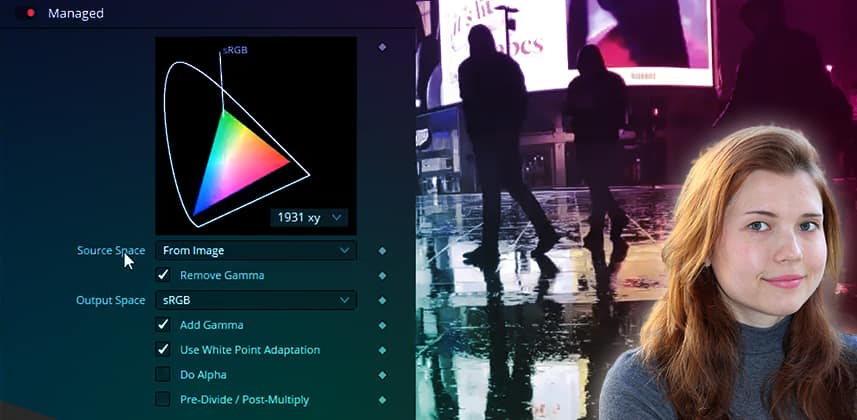| Series |
|---|
Publishers note : Team Mixing Light is thrilled to welcome our newest contributor, Daria Fissoun! She’s a London-based finishing artist specializing in commercial video projects and has worked on both US and UK feature productions – including a role as a post-production engineer on several Disney+ films. She also develops training materials for Blackmagic Design’s DaVinci Resolve software and has written Blackmagic’s official certification book, The Colorist Guide for Davinci Resolve, since its first edition in 2019.
Be sure to welcome Daria in the comments below. You can read Daria’s full bio and get the link for her website, social media handles, and YouTube channel on her Author page.
Setting up a reliable Color Managed viewer on the Fusion page
One tricky aspect of monitoring your image within DaVinci Resolve’s Fusion page is that the page uses the VFX standard of sRGB Linear as its output. This is why your images on the Fusion page look different from the rest of the software when you’re working in Fusion with DaVinci Color Managed or ACES enabled. The visual mismatch between pages leads to tremendous confusion and frustration!
This Insight will help you gain an understanding of this problem and offer several workarounds to eliminate this problem. I’ll be using HDR DaVinci Wide Gamut Intermediate as my Timeline Color Space for this example (but you can adapt these solutions to any Timeline Color Space).
I think DaVinci Wide Gamut (DWG) is an incredible working space within DaVinci Resolve that allows filmmakers to master various SDR and HDR camera formats and output to all currently recognized industry standards. This makes it a very flexible color processing mode. Due to its extra wide gamut, it even supports formats that have yet to be created, making it a (in theory) future-proof standard.
Gain control of image monitoring on the Fusion page (for any color gamut)
In this Insight, you learn various monitoring solutions that enable you to match your Fusion compositions across all pages in DaVinci Resolve – and your external monitor.
After understanding how these solutions work, you can construct your own monitoring CSTs (color space transforms) and/or LUTs to accommodate your media sources and monitoring equipment.
Here’s one more monitoring in-case-of-emergency-break-glass solution for the Fusion page:
Not mentioned in the video – another simple solution is to bypass the color management of the Fusion composition altogether! With Resolve Color Management enabled in your Project Settings:
- Right-click the Fusion Composition in the Edit page and select Bypass Color Management
- Ensure there are no CSTs or Fusion Viewer LUTs active in the Fusion page
The image will be perfectly matched across all pages of DaVinci Resolve. Though this is a simple solution (and could save your project if you’re desperate against a deadline),this is not advisable as a workflow solution. The Fusion composition will now be outside the bounds of project color management.
What does that mean?
If you deliver to multiple standards, the Fusion comp will not react to your Output Color Space changes. Plus, the comp will not use your DaVinci Wide Gamut settings. I encourage you to build a more reliable and reusable solution – and that’s what this (and a subsequent) Insight will do for you.
Key takeaways from this Insight
By the end of this Insight, you should understand how to:
- Monitor a Fusion composition with the help of a Color Space Transform node
- Set up the Fusion Viewer LUT to accurately display your composition in Fusion’s viewers
- Build your own monitoring LUT on the Color page and assign it to the Fusion Viewer
- Important downsides and limitations of the various methods presented in this Insight
- A quick ‘rule of thumb’ for deciding whether to enable the Forward OOTF setting (or not)
Related Mixing Light Insights
Please add links to any external services or website (or anything you else you mentioned in this video).
- Resolve’s Color Space Transform node – Search results on the Insight Library for Insights related to the ‘Color Space Transform’ node on the Fusion and Color pages.
- Mailbag: Color Management The ‘Right’ Way? – Team Mixing Light discusses if project-wide or more custom approaches to color management are the ‘right’ way to do things.
- Tutorial Category: Resolve Color Management – All Insights marked with the category tag ‘Resolve Color Management’.
Questions or Comments? Start a discussion thread below!
Is this Insight useful to you? Let me know! Mixing Light is all about community discussions and we’re curious if you found this helpful, if you have something to add, or if you have more questions you need answered.
– Daria


